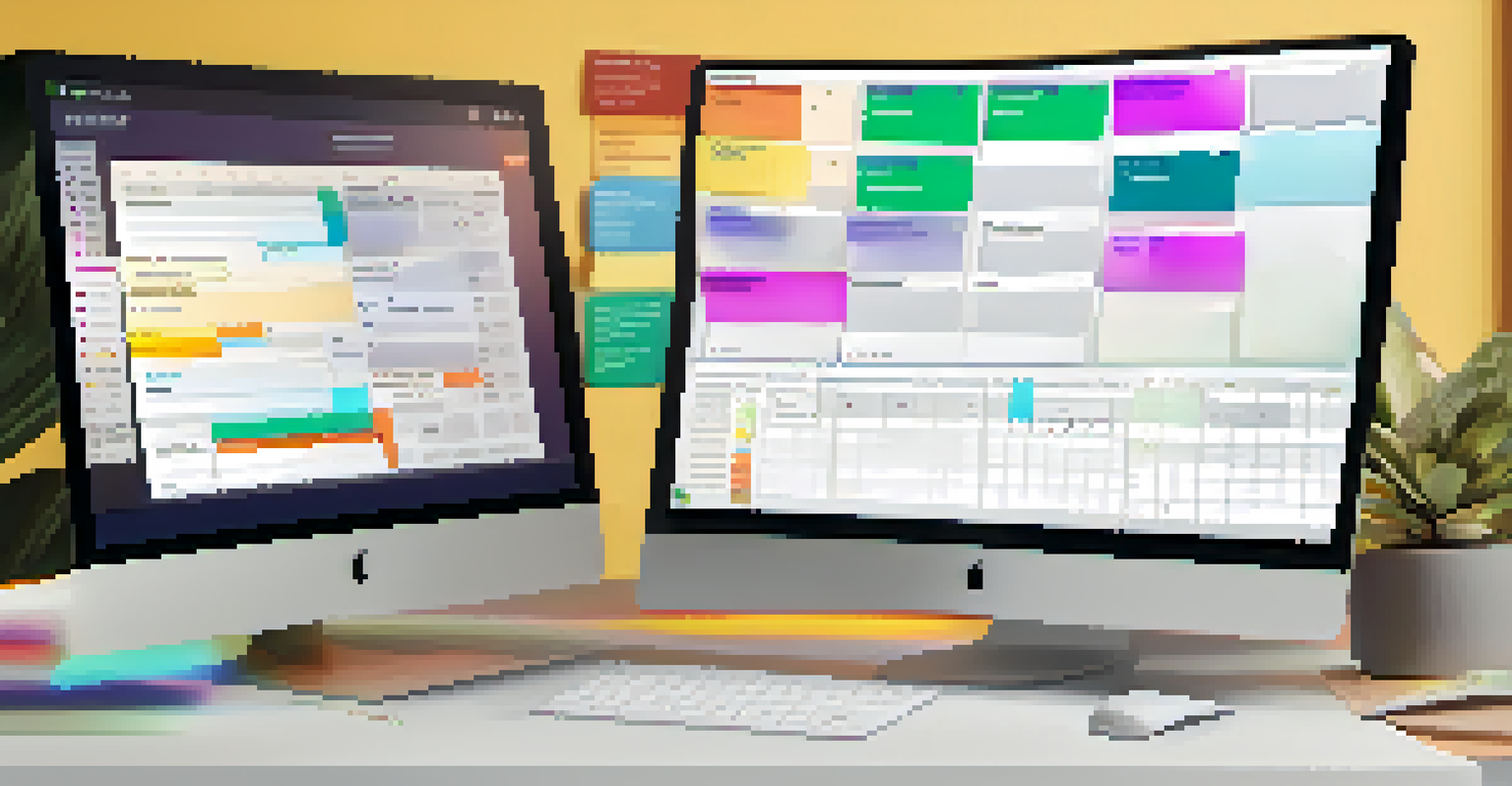Effective Communication Tools for Remote Teams in 2023

The Rise of Remote Work and Its Communication Challenges
In the past few years, remote work has transitioned from a trend to a mainstay in many industries. With teams spread across different locations, effective communication has become more crucial than ever. However, this shift has also introduced challenges like miscommunication and feelings of isolation among team members.
The ability to communicate effectively is the key to success in any organization, especially in a remote work environment.
To combat these issues, organizations need to adopt tools that facilitate seamless interaction and collaboration. The right communication tools can bridge the gap, allowing for real-time discussions and team cohesion, regardless of physical distance. Understanding these challenges and addressing them with the right solutions is essential for productivity.
As we delve into the various communication tools available in 2023, we'll discover how they can help remote teams navigate their unique hurdles. From instant messaging to video conferencing, these tools not only enhance communication but also foster a sense of belonging among team members.
Instant Messaging Platforms: Quick and Efficient Communication
Instant messaging platforms like Slack and Microsoft Teams have revolutionized the way remote teams communicate. They offer a space for quick questions, casual chats, and project updates, all in real-time. This immediacy can help teams stay connected and engaged, reducing the chances of miscommunication.

Moreover, these platforms often integrate with other tools, allowing users to share files, conduct polls, and even manage tasks without leaving the conversation. This integration fosters a more organized workspace and enhances collaboration, making it easier for teams to stay on the same page.
Remote Work Needs Strong Communication
Effective communication is crucial for remote teams to prevent miscommunication and feelings of isolation.
While instant messaging is excellent for quick interactions, it’s important to establish guidelines to prevent information overload. Encouraging teams to use channels effectively and practice digital etiquette can lead to a more productive communication environment.
Video Conferencing: Bringing Teams Together Virtually
Video conferencing tools like Zoom and Google Meet have become staples for remote teams in 2023. These platforms enable face-to-face interactions, which can significantly enhance understanding and build stronger relationships among team members. The visual element of communication helps convey tone and emotions that might be lost in text.
Remote work is not about where you work, but how effectively you communicate and collaborate with your team.
Additionally, video conferencing allows for more engaging meetings, complete with screen sharing and virtual whiteboards for brainstorming sessions. This engagement can lead to more productive discussions, fostering creativity and collaboration. Plus, the ability to record meetings ensures that no one misses out on important information.
However, it’s essential to strike a balance between video calls and other forms of communication. While face-to-face interaction is valuable, too many meetings can lead to fatigue. Establishing a clear meeting agenda and keeping sessions concise can help maximize productivity.
Project Management Tools: Keeping Everyone Aligned
Project management tools like Asana, Trello, and Monday.com play a crucial role in keeping remote teams organized. These platforms provide a centralized location for task assignments, deadlines, and project updates, ensuring everyone knows their responsibilities. This clarity helps prevent confusion and fosters accountability.
Additionally, these tools often include features like progress tracking and reporting, allowing teams to monitor their performance over time. By visualizing project timelines and individual contributions, team members can celebrate milestones and identify areas for improvement. This transparency cultivates a sense of shared purpose.
Tools Enhance Team Collaboration
Using the right communication tools, like instant messaging and video conferencing, helps remote teams stay connected and engaged.
Using project management tools can also enhance team communication by providing context for discussions. When team members can easily reference tasks and updates, conversations become more focused and productive, ultimately leading to better outcomes.
Collaborative Document Editing: Working Together in Real-Time
Collaborative document editing tools like Google Docs and Notion have transformed how teams create and share content. These platforms allow multiple users to work on the same document simultaneously, making real-time collaboration seamless and efficient. This feature is particularly beneficial for brainstorming sessions and feedback loops.
By enabling team members to see changes as they happen, these tools reduce the chances of miscommunication and duplicated efforts. Everyone can contribute their ideas and edits, fostering a more inclusive environment where every voice is heard. Plus, the option to leave comments enhances discussions and clarifies intentions.
However, it's vital to establish a clear structure for document organization to prevent chaos. Creating templates and guidelines can streamline the editing process, ensuring that everyone knows where to find information and how to contribute effectively.
Time Zone Management: Scheduling Made Simple
With remote teams often spanning multiple time zones, coordinating schedules can be a challenge. Tools like World Time Buddy and Google Calendar allow teams to view available times across different regions, making it easier to plan meetings and collaborative sessions. This accessibility helps prevent scheduling conflicts and respects everyone’s work hours.
Incorporating time zone management tools into your team's workflow can greatly reduce frustration. By setting standard meeting times that accommodate the majority, teams can ensure that everyone feels included and valued. This consideration fosters a supportive team culture, even from a distance.
Feedback Drives Team Improvement
Regular feedback through dedicated tools fosters an open culture and empowers team members to share insights for continuous improvement.
Furthermore, using shared calendars not only aids in scheduling but also keeps team members informed about each other's availability. This transparency can lead to more efficient communication and a stronger sense of teamwork.
Feedback Tools: Enhancing Communication Through Insights
Feedback tools like SurveyMonkey and 15Five enable remote teams to gather insights and opinions regularly. By encouraging team members to share their thoughts on projects, processes, and team dynamics, organizations can foster an open culture of communication. This practice not only identifies areas for improvement but also empowers employees to voice their concerns.
Moreover, these tools facilitate anonymous feedback, allowing team members to express themselves candidly without fear of repercussions. This anonymity can lead to more honest and constructive criticism, ultimately benefiting the team as a whole. Regular feedback loops help teams adapt and evolve in a fast-paced remote environment.

However, it’s crucial to act on the feedback received. Acknowledging input and making necessary changes demonstrates that leadership values employee opinions, fostering trust and engagement within the team.
Choosing the Right Tools: Tailoring Solutions to Your Team
With so many communication tools available, choosing the right ones for your remote team can be overwhelming. It’s essential to consider your team's specific needs and workflows before committing to any platform. Conducting a needs assessment can help identify which tools will support your team’s objectives best.
Additionally, involving team members in the decision-making process can increase buy-in and ensure everyone feels comfortable using the chosen tools. Providing training and support can also ease the transition and maximize the effectiveness of the new solutions. Remember, the goal is to enhance communication, not complicate it.
Ultimately, the right mix of tools can elevate your team's performance and collaboration. By remaining adaptable and open to new technologies, remote teams can continue to thrive in the evolving landscape of work.